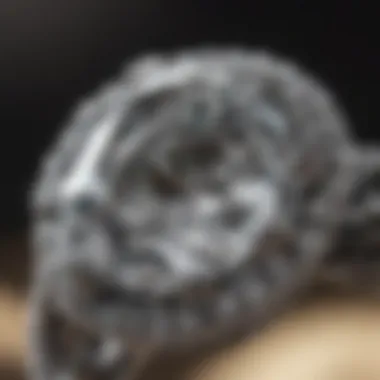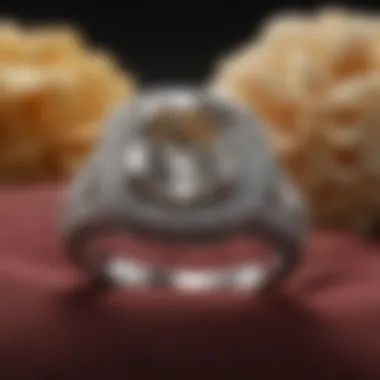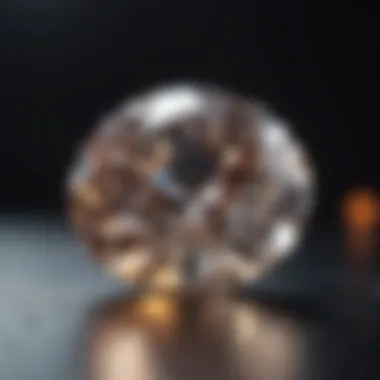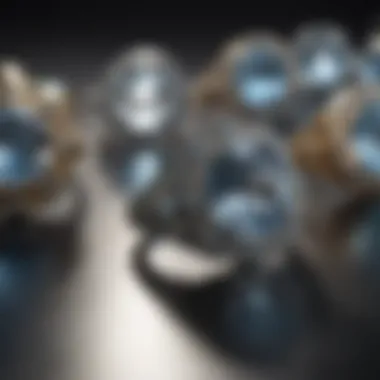The Intricacies of Cubic Diamond Rings: A Comprehensive Guide


Intro
Cubic diamond rings represent an intriguing blend of beauty and practicality in the jewelry world. They offer both aesthetic allure and practicality often sought by modern consumers. Understanding their background and characteristics is vital for anyone interested in acquiring or appreciating these unique gems.
Gemstone Overview
Definition and Origins
Cubic diamond, commonly known as cubic zirconia, is a synthesized gemstone that imitates the features of natural diamonds. This artificial gem was first created in the 1970s. Scientists developed it to mimic the brilliance and clarity associated with diamonds but at a far more accessible price point. Cubic zirconia has since gained popularity for its durability and visual appeal.
Historical Significance
Though cubic zirconia is a modern invention, it wears a substantial significance in the lore of jewelry. As an alternative to diamonds, it allows many people to access a semblance of luxury without straining their finances. In the 1980s and 1990s, cubic zirconia became a staple in fashion jewelry, reflecting a shift in societal values around beauty and status. More recently, it has found a place in fine jewelry, bridging the gap between affordability and sophistication.
Gemstone Properties
Hardness and Durability
Cubic zirconia boasts impressive hardness, scoring 8 to 8.5 on the Mohs scale. This places it below natural diamonds, which score a 10. Nevertheless, its durability means it can withstand daily wear while maintaining its visual charm. Users appreciate cubic diamond rings for their resistance to scratches and chips in comparison to softer gemstones.
Color and Clarity
Color and clarity are pivotal in the allure of cubic diamonds. They are available in various colors, from classic clear to vibrant blues, reds, and more. Clarity is typically high, and inclusions are rare, giving the stone an eye-clean appearance. This makes cubic zirconia an appealing option for those who want a striking stone without the imperfections that sometimes characterize natural diamonds.
“Cubic zirconia offers a unique solution for jewelry lovers seeking beauty without breaking the bank.”
This overview of cubic diamond rings sets the stage for further exploration into selection criteria, setting styles, care tips, and market trends. Understanding these aspects enables buyers to make informed decisions, appreciating both the artistic and financial significance of these rings.
Prologue to Cubic Diamond Rings
Cubic diamond rings have gained significant popularity in recent years, attracting both enthusiasts and casual buyers. Their importance lies in their unique combination of aesthetics and practicality. Unlike traditional diamonds, cubic diamonds often present a more accessible option for those seeking beauty without the steep price tag associated with natural gemstones. This accessibility does not compromise the charm or allure of cubic diamond rings, making them an attractive choice in the jewelry market.
Definition and Characteristics
Cubic diamond, often referred to as cubic zirconia, is a synthetic gemstone that closely resembles a diamond in its appearance. The key characteristic of cubic diamonds is their ability to mimic the brilliance and clarity of natural diamonds. These gemstones undergo a rigorous creation process, resulting in a product that is both durable and visually appealing.
Cubic diamonds are lauded for their properties:
- Hardness: Although not as hard as natural diamonds, cubic diamonds rank high on the Mohs scale, making them suitable for everyday wear.
- Clarity: They exhibit high clarity with minimal inclusions, a feature preferred by many jewelry buyers.
- Brilliance: The way light interacts with cubic diamonds often gives them a sparkle rivaling that of traditional diamonds.
These characteristics contribute to their growing reputation in various jewelry settings.
Historical Background
The inception of cubic diamonds can be traced back to the late 20th century when advancements in crystal growth technology enabled the creation of high-quality synthetic gems. Initially, these stones were introduced as affordable alternatives to natural diamonds in the fashion industry. Over time, they positioned themselves not just as substitutes but as viable options in their own right.
Cubic diamonds found their place in popular culture, being featured in costume jewelry and mainstream designs. This versatility has attracted a diverse market, including those who appreciate the aesthetic values without the constraints of ethical considerations often associated with mining traditional diamonds.
As the craft of jewelry design evolved, so did the designs featuring cubic diamonds, leading to the creation of unique and intricate pieces that appeal to different tastes and preferences. Today, cubic diamond rings not only signify style but also represent a choice for conscious consumers seeking to make informed decisions regarding gem acquisitions.
Understanding Cubic Diamond
The concept of cubic diamonds is crucial in the study of modern jewelry. These gemstones are known for their unique properties, which differ significantly from traditional diamonds. Understanding cubic diamonds allows potential buyers to make informed decisions regarding their selection. This section aims to elucidate what a cubic diamond is, alongside its defining qualities. This knowledge serves as a foundation for appreciating cubic diamond rings and their various applications in fashion.


What is Cubic Diamond?
Cubic diamond, also known as cubic zirconia, is a synthetic gemstone. It is often used as an affordable alternative to natural diamonds. The primary advantage of cubic diamonds lies in their created perfection; they can be manufactured to exact standards. This makes them more uniform than natural diamonds, which may contain flaws. Moreover, unlike natural diamonds, cubic diamonds do not require mining, positioning them as a more environmentally conscious choice.
Properties of Cubic Diamond
Cubic diamonds possess several notable properties that distinguish them in the gemstone market. These properties include hardness, clarity, and brilliance, each playing a significant role.
Hardness
Hardness refers to a material's resistance to scratching. Cubic diamonds have a hardness level of 8.5 to 9 on the Mohs scale. This places them just below natural diamonds, which rate at a perfect 10. The high hardness of cubic diamond contributes to its longevity and durability, making it an excellent choice for everyday wear. For potential buyers, its hardness means less worry about scratches and damage, which is a common concern with softer stones.
Clarity
Clarity in a gemstone defines the absence of inclusions or blemishes. Cubic diamonds are typically flawless because they are crafted under controlled conditions. This feature enhances their appeal, as clarity is a key factor in the overall beauty of a gemstone. Many consumers prefer cubic diamonds for their clear appearance and lack of defects. However, it is essential to recognize that this lack of natural imperfections can also make them less desirable for purists who favor the uniqueness of a natural stone.
Brilliance
Brilliance refers to the amount of light a gemstone reflects back to the viewer. The brilliance of cubic diamonds is exceptional due to their superior cut and clarity. They are engineered to maximize light return, resulting in a dazzling appearance. This makes them a popular choice for various jewelry designs. Potential buyers appreciate the vibrancy and sparkle of cubic diamonds, often likening them to high-quality natural diamonds. However, some may perceive this brilliance as too artificial, impacting personal preference.
In summary, understanding cubic diamonds encompasses their definition and distinctive properties. This knowledge is essential for gemstone enthusiasts and collectors, empowering them to navigate choices in cubic diamond rings effectively.
Cubic Diamond vs. Traditional Diamonds
Cubic diamond and traditional diamonds each offer distinct advantages. Understanding these differences is essential for consumers making informed decisions about their jewelry choices. This section examines critical aspects such as cost, ethics, and availability, shedding light on how they shape the choice between cubic and traditional diamonds.
Comparative Analysis
Cost
The cost of cubic diamonds is often significantly lower compared to traditional diamonds. This factor makes cubic diamonds a favorable choice for many consumers, especially those on a budget. Traditional diamonds involve not only the gemstone's cost but also additional expenses related to certification and mining.
Unique to cubic diamonds is their origin; they can be manufactured inexpensively. This results in lower retail prices. Consumers can buy larger stones or more elaborate designs without exceeding their budget. Ultimately, the cost of cubic diamond makes it a smart option for value-conscious shoppers.
Ethics
Ethical considerations heavily influence today's market choices. Cubic diamonds shine in this respect. The traditional diamond industry has long been critiqued for conflict stones and poor labor practices. In contrast, cubic diamonds are typically produced in labs. This means all their production is traceable and transparent.
The ethical aspect positions cubic diamonds as a responsible choice for afluent consumers. By opting for these gems, buyers can support sustainable and ethical practices. This provides peace of mind about their jewelry and its impact on society.
Availability
The availability of cubic diamonds contrasts sharply with traditional diamonds. Lab-created cubic diamonds are readily available in various styles, sizes, and settings. This access enables consumers to find a piece that resonates with their aesthetic without compromising on quality.
In contrast, traditional diamonds can sometimes be scarce, depending on quality and color. This scarcity often leads to inflated prices. Clients can face challenges in sourcing specifically desired characteristics. Therefore, cubic diamond availability is a notable advantage, providing consumers greater choice and flexibility.
Consumer Perception
Consumer perception around cubic diamonds is evolving. Some still view them with skepticism, thinking they are not genuine or inferior to traditional diamonds. However, as awareness grows, many consumers recognize their beauty and ethical foundations. Educated buyers often prefer cubic diamonds due to value, ethics, and sustainability.
In summary, cubic diamonds present substantial benefits over traditional diamonds. By examining cost, ethics, and availability, buyers can make choices that align with their values and tastes.
Selecting Cubic Diamond Rings
Choosing a cubic diamond ring is a significant decision for any buyer. It involves careful consideration of several factors that can influence both the aesthetic appeal and long-term value of the ring. Understanding the selection process helps buyers navigate the complexities associated with cubic diamond rings. Making informed choices ensures that the final piece reflects personal style while meeting budgetary constraints.


Key Selection Criteria
Cut
The cut of a cubic diamond is crucial. It affects how the stone reflects light, contributing to its sparkle and brilliance. A well-cut stone enhances the overall beauty and can elevate a modestly priced ring into something truly stunning. Buyers often prefer shapes like round, princess, or emerald. These cuts are popular due to their timeless appeal. However, different cuts can hide or emphasize specific flaws. It's important to assess quality in relation to cut to avoid disappointments.
Color
The color of a cubic diamond also plays an important role in its visual impact. Cubic diamonds can come in a range of colors. Commonly, clarity is prioritized in the purchasing decision. Many buyers prefer near-colorless stones for their elegance. However, deeper colors can sometimes offer a unique charm or personality to the piece. Be aware that color can affect resale value, and understanding the nuances here assists in making a better buying decision.
Setting Style
The setting style enhances the cut and color of the cubic diamond. It serves as the foundation of how the stone is presented. Popular options include solitaire, halo, and three-stone settings. Each brings distinct aesthetics to the overall look of the ring. For example, the halo style can make a diamond appear larger while adding more shine. When selecting a setting, consider both functionality and style, as different settings may accommodate different lifestyles.
Budgeting for Your Purchase
Budgeting is crucial when selecting cubic diamond rings. Determine a realistic expenditure based on research and personal financial parameters. Keep in mind that while cubic diamonds can be more affordable than their traditional counterparts, quality still holds importance. Setting a budget allows buyers to make informed decisions, ensuring that they find the perfect ring without overspending. Make a priority list which can help in managing the most critical aspects of the ring.
Popular Setting Styles for Cubic Diamond Rings
When selecting a cubic diamond ring, the setting is as crucial as the diamond itself. The style of setting impacts the overall appearance of the ring and can influence how the stone interacts with light and showcases its brilliance. Different settings also carry unique symbolism and aesthetic appeal, reflecting personal taste. This section dives into the most popular setting styles, highlighting their distinct characteristics and benefits.
Solitaire Settings
Solitaire settings emphasize simplicity and elegance. This classic design features a single cubic diamond, typically perched on a sleek band. A solitaire ring directs all attention to the diamond, allowing its quality and brilliance to shine without distraction. This style offers versatility; it can suit formal occasions and everyday wear alike.
Moreover, solitaires are often seen as a symbol of commitment and love, making them a popular choice for engagement rings. The stark simplicity allows for a range of metal choices, from gold to platinum, to match personal style preferences.
Halo Settings
Halo settings surround the central cubic diamond with a ring of smaller stones, which amplifies its size and brilliance. This design not only enhances the visual impact of the main diamond but also adds a touch of glamour.
One benefit of halo settings is their ability to create the illusion of a larger stone. The surrounding diamonds reflect light, making the center stone appear more radiant. This style pairs well with vintage and modern designs, offering a dynamic range of looks. The halo can also be configured in various shapes, whether round, oval, or more intricate designs, adding unique personalization to the ring.
Vintage Styles
Vintage styles take inspiration from historical jewelry designs, ranging from art deco to Victorian aesthetics. These settings are known for their intricate detailing and craftsmanship. Vintage cubic diamond rings often feature filigree work, engraving, and unique stone arrangements that tell a story of their own.
Choosing a vintage setting can convey a sense of nostalgia and timelessness. The artistry involved in these designs often means that no two pieces are alike, allowing for a statement ring that is uniquely yours. It also appeals to those who appreciate the craftsmanship of past eras while still wanting the modern advantages of cubic diamond materials.
Remember: The choice of setting can significantly alter the appearance and meaning of your cubic diamond ring. Consider what each style represents, as it can enhance not just the visual but also the emotional value of the piece.
Cubic Diamond Care and Maintenance
Caring for cubic diamond rings is essential to ensure they maintain their beauty and longevity. These gems, while durable, can still be affected by various factors such as dirt, oils, and environmental elements. Proper care not only enhances their appearance but also preserves their value over time. Understanding specific cleaning methods and storage guidelines can greatly benefit both the aesthetic and investment aspects of cubic diamond rings.
Cleaning Techniques
Cleaning cubic diamond rings should be part of regular maintenance. A simple, effective method includes the following steps:
- Use a Soft Brush: A soft-bristled brush can help remove dirt and debris. Toothbrushes with soft bristles are ideal for this task. Gently scrub the surface and the underside of the stone where dirt accumulates.
- Soapy Water Solution: Prepare a mixture of warm water and mild dish soap. Soak the ring for about 10-15 minutes. This time allows soap to break down oils and dust, making it easier to clean.
- Rinse Thoroughly: After soaking, rinse the ring under lukewarm water. Ensure that no soap remains, as residue can dull the shine.
- Dry Carefully: Use a microfiber cloth to dry the ring. This type of cloth is gentle and helps in avoiding scratches.
Regularly cleaning your cubic diamond ring can help maintain its sparkle and clarity.
Storage Recommendations


In addition to regular cleaning, proper storage is vital for preserving cubic diamonds. Consider the following points:
- Use Soft Pouches or Boxes: Store individual rings in soft pouches or lined jewelry boxes. This avoids scratching the surface of other rings or jewels.
- Avoid Humidity: Store rings in a cool, dry place. Humidity can affect the metal setting and overall look of the diamond.
- Limit Exposure to Chemicals: Keep cubic diamond rings away from harsh chemicals and cleaning products. These substances can tarnish the metal and cloud the stone's clarity.
- Regular Inspection: Periodically check the ring for any signs of wear, loose settings, or scratches. This ensures any issue is addressed before it becomes significant.
Caring for your cubic diamond ring not only preserves its beauty but also represents a sensible approach to your investment in these stunning gemstones.
Common Misconceptions about Cubic Diamonds
Understanding the misconceptions surrounding cubic diamonds is essential for both consumers and enthusiasts. These gems often face skepticism due to their unique composition and market position. Clarifying these misunderstandings not only educates potential buyers but also helps in appreciating the true value and qualities of cubic diamond rings.
Cubic Diamonds Are Fake
One of the most widespread misconceptions is that cubic diamonds are merely faux or imitation stones. This belief stems from a lack of knowledge about what cubic diamonds actually are. To clarify, cubic diamonds, formally known as cubic zirconia, are synthetic gemstones that are created in a laboratory.
It's important to note that they are not imitations of natural diamonds. Instead, they possess unique characteristics that set them apart. Their brilliance and clarity can sometimes surpass that of natural diamonds due to their flawless nature. Moreover, cubic diamonds are made from zirconium dioxide, which is a compound that provides substantial durability and aesthetic appeal.
"Cubic zirconia is often confused with fake diamonds, but it is simply a different type of gem offering its own unique advantages."
Recognizing this distinction helps consumers appreciate cubic diamonds for their own merits rather than dismiss them as mere substitutes.
Cubic Diamonds Lack Value
Another misconception is that cubic diamonds lack intrinsic value. This belief is often based on their lower price point compared to natural diamonds. While it is true that cubic diamonds are generally more affordable, this does not diminish their worth. The value of a gemstone can be assessed through different lenses, including beauty, craftsmanship, and the joy it brings to the wearer.
Cubic diamonds possess a stunning appearance, which is why they are favored in many jewelry designs. Their affordability allows a wider audience to enjoy elegant jewelry without the prohibitive costs associated with natural diamonds. Therefore, consumers can find genuine aesthetic value in cubic diamonds, making them an excellent option for those who prioritize beauty and design over investment potential.
Market Trends in Cubic Diamonds
The topic of market trends in cubic diamonds is crucial in understanding their place within the broader jewelry and gemstone marketplace. Attention to these trends provides insights on consumer behavior, potential growth areas, and investment opportunities, making it relevant for both buyers and sellers. As aesthetic preferences evolve and sustainability becomes a priority, examining current trends assists enthusiasts in making informed decisions about their purchases.
Current Consumer Preferences
In recent years, consumer preferences regarding cubic diamonds have shifted considerably. Buyers now value craftsmanship and transparency. Factors influencing these preferences include:
- Sustainability: Many consumers seek ethically sourced gemstones that reduce environmental impact. Cubic diamonds often present a more sustainable choice, as they can be produced without the extensive mining associated with traditional diamonds.
- Affordability: With cubic diamonds offering similar visual appeal at a fraction of the cost, they have attracted price-sensitive consumers. This price advantage allows consumers to purchase larger or higher-quality stones compared to natural diamonds.
- Versatility in Design: The increasing interest in unique jewelry designs has led to a rise in cubic diamond settings. Buyers are looking for distinct pieces that stand out, making the cubic diamond an attractive choice for custom creations.
The trend towards personalization further solidifies cubic diamonds’ position in the market. Consumers are gravitating towards pieces that express individual style, and cubic diamonds offer numerous design possibilities to fit various aesthetics.
Investment Potential
Investing in cubic diamonds is a topic of growing interest among gem enthusiasts. While they do not carry the same historical prestige as natural diamonds, they exhibit certain advantages that may appeal to investors, including:
- Lower Entry Costs: The initial investment for cubic diamonds is significantly lower than that of traditional diamonds, making them accessible for new collectors or investors.
- Potential for Appreciation: As awareness and appreciation for cubic diamonds increases, their value may rise. Savvy investors may find opportunities in limited edition designs or exclusive collections.
- Market Demand: The increasing awareness of ethical sourcing aligns with a broader push for responsible buying practices. This encourages a growing market for cubic diamonds. As demand increases, so may the potential for value appreciation over time.
"The shift towards ethical consumerism is not just a trend but a fundamental change in how society views luxury goods."
Epilogue
Understanding cubic diamond rings is essential for anyone interested in jewelry, specifically in the realm of alternative gemstones. These rings represent more than mere accessories; they embody a blend of aesthetic appeal, ethical considerations, and potential investment value.
Cubic diamond rings, while often overlooked, carry a distinct significance against the backdrop of both traditional jewelry and contemporary trends. The uniqueness of cubic diamonds speaks to the curiosity of adventurous buyers, paving the way for choices that prioritize not just beauty but also sustainability. The lower cost compared to natural diamonds makes cubic diamonds an attractive option for those mindful of budget.
Summarizing the Importance of Cubic Diamond Rings
Cubic diamond rings uphold a unique place in the jewelry landscape. They bridge the gap between luxury and affordability, thus democratizing access to exquisite designs. The durability and brilliance in appearance can rival traditional diamonds, allowing wearers to enjoy high-quality engagement and fashion rings without excessive expenditure. In addition, cubic diamond rings often showcase innovative cuts and designs. This variety adds to their appeal, making them suitable for different personal expressions and occasions. Ultimately, these rings serve not only as fashion statements but also as conversation pieces that reflect evolving consumer values.
"Cubic diamonds uphold beauty and sustainability while appealing to diverse buyer preferences."
Final Thoughts on Choosing Cubic Diamonds
When considering a purchase, it’s vital to recognize the qualities that make cubic diamond rings desirable. Potential buyers should engage with trusted jewelry retailers, ask questions about the selection process, and become familiar with available options. Understanding essential factors such as cut, color, and setting style enhance the overall experience.



